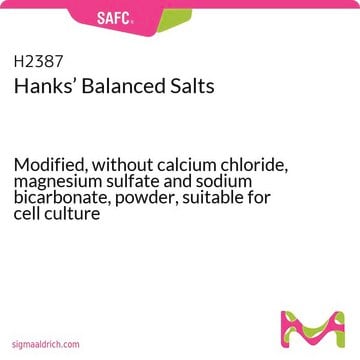H9394
Sal equilibrada de Hanks solution
Modified, with sodium bicarbonate, without calcium chloride and magnesium sulfate, liquid, sterile-filtered, suitable for cell culture
Sinónimos:
HBSS
About This Item
Productos recomendados
sterility
sterile-filtered
form
liquid
technique(s)
cell culture | mammalian: suitable
impurities
endotoxin, tested
components
NaHCO3: 0.35 g/L
glucose: 1.0 g/L (Dextro)
phenol red: 0.011 g/L
shipped in
ambient
¿Está buscando productos similares? Visita Guía de comparación de productos
Categorías relacionadas
General description
Application
- as a component of the culture medium for culturing of mouse cortical slices
- as a component of the dissociation buffer for incubation of human-induced pluripotent stem cells (hiPSCs) and hiPSC-derived cardiomyocytes (CMs)
- for in situ perfusions of mice liver
Biochem/physiol Actions
supplement
Storage Class
12 - Non Combustible Liquids
wgk_germany
WGK 1
flash_point_f
Not applicable
flash_point_c
Not applicable
Certificados de análisis (COA)
Busque Certificados de análisis (COA) introduciendo el número de lote del producto. Los números de lote se encuentran en la etiqueta del producto después de las palabras «Lot» o «Batch»
¿Ya tiene este producto?
Encuentre la documentación para los productos que ha comprado recientemente en la Biblioteca de documentos.
Los clientes también vieron
Protocolos
StableCell™ Trypsin solutions are designed to perform cell detachment as standard trypsin solutions do, without the need to aliquot, freeze, and thaw. This saves significant time before passaging.
Trypsin is commonly used for dissociating adherent cells from surfaces. A wide variety of trypsin solutions are available to meet your specific cell line requirements.
Nuestro equipo de científicos tiene experiencia en todas las áreas de investigación: Ciencias de la vida, Ciencia de los materiales, Síntesis química, Cromatografía, Analítica y muchas otras.
Póngase en contacto con el Servicio técnico






